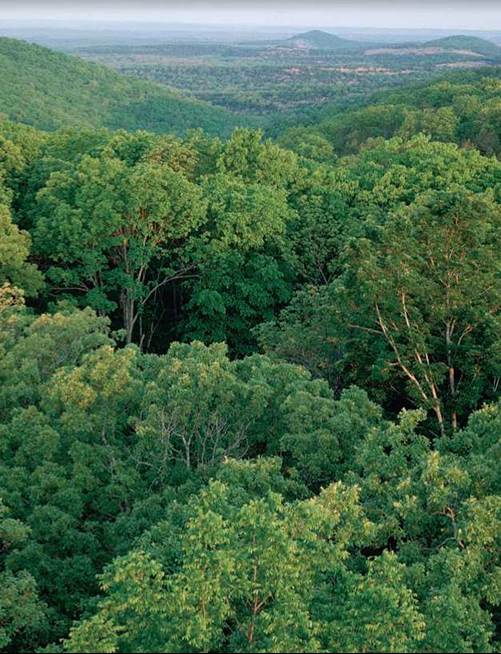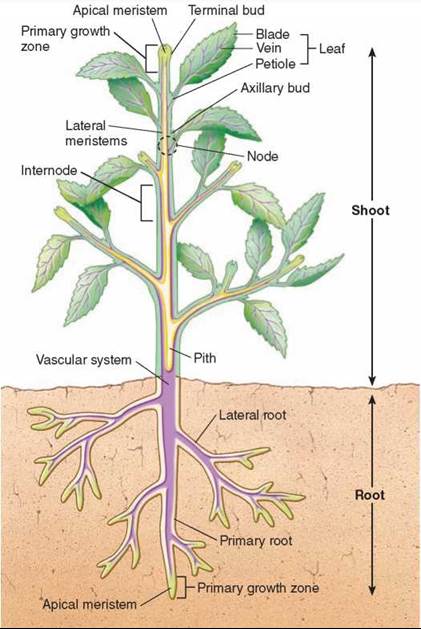THE LIVING WORLD
Unit Seven. Plant Life

Of all the many kinds of plants, trees are the largest, rising high above the surrounding vegetation to capture the sun’s rays. This hardwood forest, green with the leaves of spring, can be thought of as an enormous photosynthesis machine, each of its trees competing with its neighbors for light and soil nutrients, and putting the raw materials it captures to work producing the organic molecules necessary for growth and reproduction. Typical of plants, a tree captures light with the green pigment chlorophyll, which gives its leaves their characteristic color. A tree captures soil nutrients with its roots, which spread out in a fine network through the surrounding soil. Connecting the leaves of a tree with its roots is the stem, the massive, tall woody cylinder that makes up most of the mass of the tree. The stem of a tall tree is an engineering marvel, piping water and dissolved soil nutrients to the leaves many meters higher up in the air, and sending back down to the roots the carbohydrates produced by photosynthesis in the leaves. In this chapter, we will journey through the plant body, one of nature’s most interesting creations.
33.1. Organization of a Vascular Plant
Most plants possess the same fundamental architecture and the same three major groups of organs—roots, stems, and leaves. Vascular plants have within their stems vascular tissue, which conducts water, minerals, and food throughout the plant. The cells and tissues of vascular plants, and how the plant body carries out the functions of living, are the focus of this chapter. We discuss the fundamental differences between the roots, which are usually belowground, and the shoot, which is typically aboveground. We also examine the structural and functional relationships between them.
A vascular plant is organized along a vertical axis (figure 33.1). The part belowground is called the root, and the part aboveground is called the shoot (although in some instances roots may extend above the ground, and some shoots can extend below it). Although roots and shoots differ in their basic structure, growth at the tips throughout the life of the individual is characteristic of both. The root penetrates the soil and absorbs water and various minerals, which are crucial for plant nutrition. It also anchors the plant. The shoot consists of stem and leaves. The stem serves as a framework for the positioning of the leaves, where most photosynthesis takes place. The arrangement, size, and other characteristics of the leaves are critically important in the plant’s production of food. Flowers, and ultimately fruits and seeds, are also formed on the shoot.

Figure 33.1. The body of a plant.
The body of this dicot plant consists of an aboveground portion called the shoot (stems and leaves) and a belowground portion called the root. Elongation of the plant, so-called primary growth, takes place when clusters of cells called the apical meristems (lime green areas) divide at the ends of the roots and the stems. Thickening of the plant, so-called secondary growth, takes place in the lateral meristems (yellow areas) of the stem, allowing the plant to increase in girth like letting out a belt.
Meristems
When an animal grows taller, all parts of its body lengthen— when you grew taller as a child, your arms and legs lengthened and so did your torso. A plant doesn’t grow this way. Instead, it adds tissues to the tips of its roots and shoots. If you grew like this, your legs would get longer, and your head taller, while the central portion of your body would not change.
Why do plants grow in this way? The plant body contains growth zones of unspecialized cells called meristems. Meristems are areas with actively dividing cells that result in plant growth but also continually replenish themselves. That is, one cell divides to give rise to two cells. One remains meri- stematic, while the other is free to differentiate and contribute to the plant body, resulting in plant growth. In this way, meristem cells function much like “stem cells” in animals (see chapter 13). Molecular genetic evidence supports the hypothesis that animal stem cells and plant meristem cells may also share some common pathways of gene expression.
In plants, primary growth is initiated at the tips by the apical meristems, regions of active cell division that occur at the tips of roots and shoots, colored lime green in figure 33.1. The growth of these meristems results primarily in the extension of the plant body. As the body tip elongates, it forms what is known as the primary plant body, which is made up of the primary tissues.
Growth in thickness, secondary growth, involves the activity of the lateral meristems, which are cylinders of mer- istematic tissue, colored yellow in figure 33.1. The continued division of their cells results primarily in the thickening of the plant body. There are two kinds of lateral meristems: the vascular cambium, which gives rise to ultimately thick accumulations of secondary xylem and phloem, and the cork cambium, from which arise the outer layers of bark on both roots and shoots.
Key Learning Outcome 33.1. The body of a vascular plant is a continuous structure, a grouping of tubes connecting roots to leaves, with growth zones called meristems.